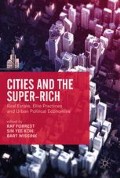Abstract
Upper-class social clubs in European metropolises have mostly been described through isolated monographs. Instead, this chapter on Milan studies them relationally. Extending the Bourdieusian approach, we show that social (and some service) clubs in Italy’s economic capital city form a relatively coherent space of distinction. Differences between clubs include historical origins, social composition, organisational features and modalities for membership. But they also pertain to the particular criteria used by each institution to describe and legitimate its social capital—that is, the links connecting its members with each other—as well as to distinguish itself from its competitors. We argue that part of the efficiency of social capital stems from the symbolic categories deployed to endow it with meaning.
Access this chapter
Tax calculation will be finalised at checkout
Purchases are for personal use only
Notes
- 1.
We would like to thank Marco Oberti, Anne Raulin, Tommaso Vitale, Diana Mauri, Silvana Mauri Ottieri, Rosellina Archinto, Lina Sotis, Enzo Mingione, Mathieu Richard, Bart Wissink, Sin Yee Koh and Ray Forrest for their support and advice in carrying out the research and writing for this chapter.
- 2.
Since the coming into force of the Constitution of the Italian Republic (on January 1st, 1948), nobility titles are no longer officially recognised by the State.
- 3.
In 2001–2002, Milan’s social clubs (especially the Unione and the Clubino) were officially against accepting professional politicians as members. This was because they considered that elected officials are inherently controversial figures, and because many clubmen from the aristocracy and the old bourgeoisie had very little sympathy for Milanese tycoon and Italian Prime Minister Silvio Berlusconi and his associates. Nevertheless, several city officials were close to the clubs. For instance, in the Moratti family (whose men are at the Clubino), Milly Moratti was a left-wing city councillor from 2001 to 2011, while her (right-wing) sister-in-law Letizia Moratti was Mayor of Milan from 2006 to 2011.
- 4.
Out of 16 founding members, five were also members of the Unione and seven would join it later.
- 5.
At the Unione, in 2001, rates were 9 per cent and 3 per cent, respectively.
References
Baltzell, E. D. (1987 [1964]). The protestant establishment: Aristocracy and caste in America. New Haven: Yale University Press.
Bagnasco, A. (1999). Teoria del capitale sociale e «political economy» comparata. Stato e mercato, 57, 351–372.
Bagnasco, A. (2002). Il capitale sociale nel capitalismo che cambia. Stato e mercato, 65, 271–304.
Boltanski, L. (2012 [First French edition: 1990]). Love and justice as competences: Three essays on the sociology of action. Cambridge: Polity.
Bourdieu, P. (1980). Le capital social: Notes provisoires. Actes de la recherche en sciences sociales, 31, 2–3.
Bourdieu, P. (1996 [First French edition: 1989]). The state nobility: Elite schools in the field of power. Redwood City: Stanford University Press.
Bourdieu, P., & Coleman, J. (Eds.). (1991). Social theory for a changing society. Boulder: Westview Press.
Camus-Vigué, A. (2000). Community and civic culture: The rotary club in France and the United States. In M. Lamont & L. Thévenot (Eds.), Rethinking comparative cultural sociology: Repertoires of evaluation in France and the United States (pp. 213–228). Cambridge: Cambridge University Press.
Coleman, J. (1990). Foundations of social theory. Cambridge, MA: The Belknap Press of Harvard University Press.
Cousin, B., & Chauvin, S. (2010). La dimension symbolique du capital social: les grands cercles et Rotary clubs de Milan. Sociétés Contemporaines, 77, 111–138.
Cousin, B., & Chauvin, S. (2012). L’économie symbolique du capital social: notes pour un programme de recherche. Actes de la recherche en sciences sociales, 194, 96–103.
De Saint Martin, M. (1989). La noblesse et les «sports» nobles. Actes de la recherche en sciences sociales, 80, 22–32.
De Saint Martin, M. (1993). L’espace de la noblesse. Paris: Métailié.
Khan, S. (2012). The sociology of elites. Annual Review of Sociology, 38, 361–377.
Milne-Smith, A. (2011). London clubland: A cultural history of gender and class in late-Victorian Britain. London: Palgrave Macmillan.
Pinçon, M., & Pinçon-Charlot, M. (1989). Dans les beaux quartiers. Paris: Seuil.
Pinçon, M., & Pinçon-Charlot, M. (1998). Grand fortunes: Dynasties of wealth in France (First German ed.). New York: Algora.
Pinçon, M., & Pinçon-Charlot, M. (2007). Les ghettos du gotha: Comment la bourgeoisie défend ses espaces. Paris: Seuil.
Pizzorno, A. (1999). Perché si paga il benzinaio: nota per una teoria del capitale sociale. Stato e mercato, 3, 373–394.
Ponthieux, S. (2006). Usages et mésusages du capital social. In A. Bevort & M. Lallement (Eds.), Le capital social: Performance, équité et réciprocité (pp. 89–105). Paris: La Découverte.
Portes, A. (2010). Social capital. In Economic sociology: A systematic inquiry (pp. 27–47). Princeton: Princeton University Press.
Silver, A. (1989). Friendship and trust as moral ideals: An historical approach. Archives européennes de sociologie, 30(2), 274–297.
Author information
Authors and Affiliations
Editor information
Editors and Affiliations
Copyright information
© 2017 The Author(s)
About this chapter
Cite this chapter
Cousin, B., Chauvin, S. (2017). Old Money, Networks and Distinction: The Social and Service Clubs of Milan’s Upper Classes. In: Forrest, R., Koh, S., Wissink, B. (eds) Cities and the Super-Rich. The Contemporary City. Palgrave Macmillan, New York. https://doi.org/10.1057/978-1-137-54834-4_8
Download citation
DOI: https://doi.org/10.1057/978-1-137-54834-4_8
Published:
Publisher Name: Palgrave Macmillan, New York
Print ISBN: 978-1-137-55715-5
Online ISBN: 978-1-137-54834-4
eBook Packages: Social SciencesSocial Sciences (R0)

